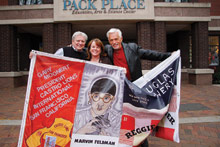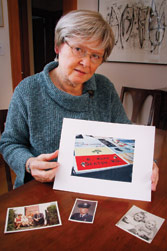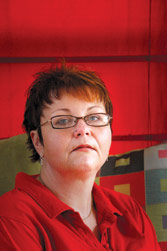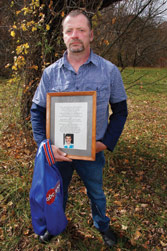Remember AIDS?
Though supplanted in the public eye by the latest disease du jour, there was a time in the ‘80s and ‘90s when you couldn’t turn around without seeing or hearing something about AIDS—which first targeted gay men yet quickly went global. Besides sparking the fear and loathing of whole classes of people, the plague also spurred cadres of dedicated men and women to devote their lives to eradicating it.

But the sheer magnitude of the AIDS epidemic manifested itself in other ways as well, some of them quite positive and life-affirming. Proving that beauty can spring from ugliness, the disease inspired artists in many media, from the iconic drawings of the late Keith Haring to popular music, major motion pictures, plays and fiction.
But perhaps the era’s quintessential icon is the 1,293,300-square-foot AIDS Memorial Quilt, housed and overseen by the Atlanta-based Names Project Foundation. And while the dread disease has largely receded from the nation’s consciousness, the quilt not only endures but continues to grow.
Begun in 1987 and billed as the world’s largest community art project, it contains more than 46,000 panels featuring more than 91,000 names of those lost to the disease—about 17.5 percent of all U.S. AIDS deaths, the foundation notes.
By now, the quilt has grown too big to be shown in its entirety, but the Western North Carolina AIDS Project, a local nonprofit, has arranged for several sections of it to be displayed at Pack Place in downtown Asheville from Nov. 24 through Dec. 1: World AIDS Day. Besides enabling area residents to reconnect with their loved ones immortalized in the quilt, the free exhibit is also meant to serve as a wakeup call that AIDS is still very real and very much in need of urgent attention and activism.
A stitch in time
Pam Siekman and her husband moved to Asheville from Washington, D.C., a little more than a year ago. Seeing that the city was doing little to specifically commemorate World AIDS Day (although WNCAP and other groups held many events throughout the year), she proposed the quilt exhibit and is coordinating it for the nonprofit. The massive quilt has been displayed in its full glory only a handful of times, most recently on the Mall in Washington in 1996. And though sections of it have been displayed at Western Carolina University, Siekman and WNCAP say this will be the first time portions of it will be on view in Asheville.

Twenty blocks—each 12 feet by 12 feet and containing eight panels—will be on display. “It’s going to be powerful,” she promises.
After Siekman and WNCAP put out a call to local folks who’d lost loved ones now immortalized in the quilt, the response was overwhelming, she says. And on Monday, Nov. 24, families and friends whose loved ones are memorialized will gather for a private reception at Pack Place from 5 to 6 p.m.
“It’s very, very meaningful for these people to come and be reunited with their loved one’s panel—for the first time, in some cases, in more than 20 years. … One of the moms told me, ‘I don’t even remember what it looks like.’ She said, ‘I remember a lot of green felt, because I was sewing in the middle of the night with tears in my eyes. It’s probably the ugliest panel in the quilt, because I was crying so hard.’”
That same night, a public opening reception will run from 6 to 7:30 p.m. And each evening of the display, local bands and musicians will entertain crowds from (see sidebar for details). “We’re trying to do everything we can to get people in there,” says Siekman, who hopes the diverse array of musical offerings will draw folks who might not otherwise come to see the quilt, as well as help lighten the mood. The weeklong run will also include movie screenings and storytelling, giving people opportunities to talk about those who’ve passed away.
On World AIDS Day, a candlelight vigil will bring community members to Pack Place to come together and tell their stories.
“In addition to people feeling connected to their loved ones, I’m hoping people will recommit to the fight against AIDS,” says Siekman. “It’s one more way to lift your voice and to know that you can make a difference.”
The 49-year-old Siekman has lost numerous close friends to AIDS, many in the disease’s early days, she says. And before drugs were available to arrest the disease and give sufferers a longer, healthier life, their deaths were excruciating.
“Back then it was a very difficult death to watch, because the virus just took over their bodies. It was a painful death back then,” she says.
And for Siekman, it’s also painful to see how AIDS has largely faded from view in America.
“It troubles me greatly, which is why I have such a passion for this work. AIDS now has just kind of been pushed aside for other diseases. Yet the numbers [of new infections] continue to be staggering,” with African-Americans and women now being hit the hardest, she says. Last year, there were more than 56,000 new infections in the United States, according to the Centers for Disease Control, and many AIDS activists fear this year’s numbers could be even worse.

The agency’s latest figures for North Carolina show at least 11,760 persons living with HIV, while 8,463 have full-blown AIDS. The rate of infection is nearly 14 people per 100,000. It’s hard to get a firm handle on the extent of the problem in Buncombe County due to its high transient population, some of whom may have been diagnosed elsewhere and are not using public health services here. WNCAP staffers say the nonprofit is handling more than 360 cases, though the actual numbers of people in our region with the virus or the disease are much higher.
“I think we hear more about AIDS in Third World countries today than we do in the United States,” laments WNCAP Executive Director Ron Curran, noting that as the media pay less and less attention to the disease, U.S. infection rates have been on the increase. “That really hurts on the prevention end. [A lot of] people don’t have the experience knowing people who died and how devastating the disease was before some of the advances in medication. … But what people don’t understand is that while life for many people on the medications may be longer, it is still very compromised.”
The pain never leaves
To Harry Brown, Ronnie Angelet of Atlanta was a “soulmate” with whom he shared a deep connection that can never be broken. Angelet succumbed to AIDS in 1993, but the pain still lingers for Brown, who is WNCAP’s special-events coordinator and one of the region’s most stalwart AIDS activists. Indeed, Brown still grows wistful at the memory of the man whose photo adorns one of the quilt panels that’s on its way to Asheville.
Angelet “was a manager and maitre d’ at a restaurant in Atlanta called Gene & Gabe’s,” recalls Brown, who’s been HIV-positive himself for 20 years but currently has undetectable levels of the virus in his blood. “His bubbling, welcoming personality made the restaurant one of the top businesses in that area. I mention that because, sadly, AIDS was so rampant at that time that Ronnie was one of 13 staff individuals to have succumbed to HIV/AIDS. As far as my personal losses … there were at least 40 or more that I personally was acquainted with who died from complications from AIDS. My request for Ronnie’s quilt, in my heart, was a request and a remembrance to all those who left my life much too soon.”
Brown adds: “For young people who didn’t live through the AIDS era when so many people were dying, when they see these quilts, it’s going to be an education for them—an overwhelming event.”

Brown says he’d like to remind visitors that the quilt transcends mere decoration. “I would want people to look at each individual panel, one at a time, and realize this was someone’s life … and some of the memories that someone thought was important to embed in this piece of tapestry.”
Eva Reynolds of Black Mountain and Troy Allmond of Hendersonville have lost their share of friends, too. Both, like Brown, are HIV-positive. Reynolds remembers seeing the quilt in all its grandeur in Washington in 1996. “It was just amazing, this sea of these beautiful panels. I think what makes it so unique is that each panel on the quilt is done by somebody, lovingly, by hand. And that brings a level of emotion to the quilt that I’ve never seen in any other work of art.”
And even when viewed piecemeal, she notes, “It’s still powerful in its own way.”
Allmond, meanwhile, met Thom Kirksey in 1984 and stayed with the love of his life until Kirksey died in 1992. And though Allmond is now 15 years removed from the devastating loss, time has not eased the pain, which is palpable even during our telephone interview. Kirksey died while Allmond was in the midst of moving their possessions from Colorado to Macon, Ga., Kirksey’s hometown. And it was on Allmond’s birthday, Dec. 20, that he buried his mate.
“I have a good partner now. … I love him to death,” says Allmond. “But you can’t always replace something with something else. Thom was the apple of my eye. We were very young when we met; if he were alive today, we’d still be together.” Allmond says he and his current partner “have been together six years in April. He’s a good guy, a good man. He’s very understanding and supportive about Thom. But there’s just different kinds of love.”
No less emotion can be heard in the voice of Heather Yurgeles, a 70-year-old Asheville woman who lost her brother, Dr. Robert Seaton, to AIDS in 1985. Seaton’s quilt panel is another of the many that will be on display locally.
For Yurgeles, her brother’s death also meant the loss of a portion of her family’s institutional memory. The lone survivor now, she no longer has her brother to help fill in gaps in the family history.
Yurgeles reckons she hasn’t seen her gay brother’s quilt panel since 1991. Made by a group of nurses Seaton worked with in Vietnam “who simply loved and adored him,” she says, “It’s just a red background with his name on it—certainly not what I would have made, but they made it with love.” And when Yurgeles sees it again, she says, “It’s going to be emotional.”
Asheville resident Don Streb knows the feeling. His brother, Bill, who died in 1992, has four panels, one of which is coming to town. The last time Streb saw the panels was on the Mall in 1996.
“Personally, it was devastating,” he recalls. “The experience was extremely, extremely difficult. My brother and I were very close; we weren’t twins, but we might as well have been, born 17 months apart. We literally did everything together, the last two of a large family. When we were younger, our mother even dressed us alike.
A tapestry of memories
Twenty blocks of the AIDS Memorial Quilt will be on display in the lobby of Pack Place in downtown Asheville from Monday, Nov. 24, through Monday, Dec. 1. Admission is free, and the hours most days are 10 a.m. to 7 p.m. (closed on Thanksgiving; reduced hours on Sunday, Nov. 30).
At least 20 of the 160 people memorialized on the panels had ties to Asheville and Western North Carolina, coordinator Pam Siekman explains.
A kickoff reception on Nov. 24 will run from 6 p.m. to 7:30 p.m. with food and entertainment. A diverse array of local musicians will entertain guests from 5 p.m. to 7 p.m. most days. The Asheville Art Museum will be showing the AIDS documentary Just As I Am Nov. 29 and 30, and a candlelight vigil on Dec. 1—World AIDS Day—will close out the exhibit at 7 p.m.
For more information, or to volunteer to help, go to www.wncap.org, or call 252-7489.
“I always said we were like the seasons of the year,” continues Streb. “We were spring, growing and developing, blossoming out. Summer was playful and fun. Fall is when we mellowed and were beginning to change and mature … and finding our degree of independence and individual ways. And winter is when I lost him.
“He was a hero to me. He was a guy who always put principles first. … I think of one particular time when he saw an effeminate young man being picked on and harassed, and he stepped in and did everything he could to defend him. And he literally had the crap beaten out of him where we had to take him to the hospital. He always believed he should always speak up for what he believed in. He didn’t feel that any person—black, yellow, red, gay, lesbian or transgendered—should ever have to suffer any inequalities.
Streb’s voice is silenced now, along with those of the others immortalized in the quilt. But their friends, families and partners hope these inanimate pieces of cloth will speak volumes to a younger generation and to all those who mistakenly believe that AIDS is no longer a big concern.
“We have a generation of young people, both straight and gay, that have not been through the horror of the AIDS pandemic,” says Streb. “Hopefully this quilt will promote some strong awareness to the general public about just what a devastating illness this is.”



Before you comment
The comments section is here to provide a platform for civil dialogue on the issues we face together as a local community. Xpress is committed to offering this platform for all voices, but when the tone of the discussion gets nasty or strays off topic, we believe many people choose not to participate. Xpress editors are determined to moderate comments to ensure a constructive interchange is maintained. All comments judged not to be in keeping with the spirit of civil discourse will be removed and repeat violators will be banned. See here for our terms of service. Thank you for being part of this effort to promote respectful discussion.